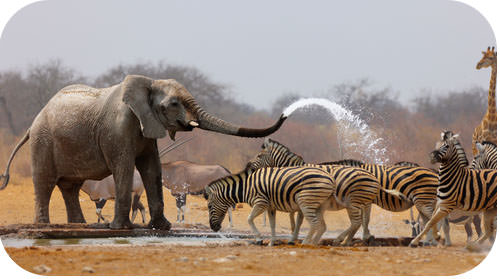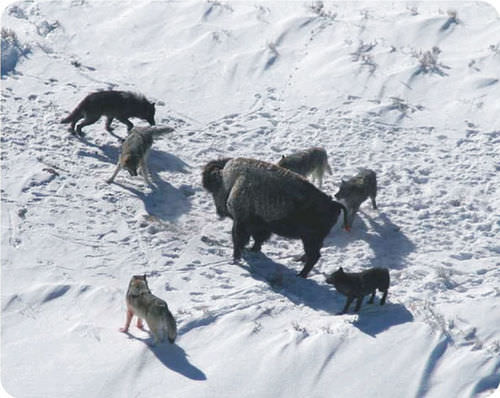10.3: Animal Behavior Evolution
- Page ID
- 1394
\( \newcommand{\vecs}[1]{\overset { \scriptstyle \rightharpoonup} {\mathbf{#1}} } \)
\( \newcommand{\vecd}[1]{\overset{-\!-\!\rightharpoonup}{\vphantom{a}\smash {#1}}} \)
\( \newcommand{\dsum}{\displaystyle\sum\limits} \)
\( \newcommand{\dint}{\displaystyle\int\limits} \)
\( \newcommand{\dlim}{\displaystyle\lim\limits} \)
\( \newcommand{\id}{\mathrm{id}}\) \( \newcommand{\Span}{\mathrm{span}}\)
( \newcommand{\kernel}{\mathrm{null}\,}\) \( \newcommand{\range}{\mathrm{range}\,}\)
\( \newcommand{\RealPart}{\mathrm{Re}}\) \( \newcommand{\ImaginaryPart}{\mathrm{Im}}\)
\( \newcommand{\Argument}{\mathrm{Arg}}\) \( \newcommand{\norm}[1]{\| #1 \|}\)
\( \newcommand{\inner}[2]{\langle #1, #2 \rangle}\)
\( \newcommand{\Span}{\mathrm{span}}\)
\( \newcommand{\id}{\mathrm{id}}\)
\( \newcommand{\Span}{\mathrm{span}}\)
\( \newcommand{\kernel}{\mathrm{null}\,}\)
\( \newcommand{\range}{\mathrm{range}\,}\)
\( \newcommand{\RealPart}{\mathrm{Re}}\)
\( \newcommand{\ImaginaryPart}{\mathrm{Im}}\)
\( \newcommand{\Argument}{\mathrm{Arg}}\)
\( \newcommand{\norm}[1]{\| #1 \|}\)
\( \newcommand{\inner}[2]{\langle #1, #2 \rangle}\)
\( \newcommand{\Span}{\mathrm{span}}\) \( \newcommand{\AA}{\unicode[.8,0]{x212B}}\)
\( \newcommand{\vectorA}[1]{\vec{#1}} % arrow\)
\( \newcommand{\vectorAt}[1]{\vec{\text{#1}}} % arrow\)
\( \newcommand{\vectorB}[1]{\overset { \scriptstyle \rightharpoonup} {\mathbf{#1}} } \)
\( \newcommand{\vectorC}[1]{\textbf{#1}} \)
\( \newcommand{\vectorD}[1]{\overrightarrow{#1}} \)
\( \newcommand{\vectorDt}[1]{\overrightarrow{\text{#1}}} \)
\( \newcommand{\vectE}[1]{\overset{-\!-\!\rightharpoonup}{\vphantom{a}\smash{\mathbf {#1}}}} \)
\( \newcommand{\vecs}[1]{\overset { \scriptstyle \rightharpoonup} {\mathbf{#1}} } \)
\( \newcommand{\vecd}[1]{\overset{-\!-\!\rightharpoonup}{\vphantom{a}\smash {#1}}} \)
\(\newcommand{\avec}{\mathbf a}\) \(\newcommand{\bvec}{\mathbf b}\) \(\newcommand{\cvec}{\mathbf c}\) \(\newcommand{\dvec}{\mathbf d}\) \(\newcommand{\dtil}{\widetilde{\mathbf d}}\) \(\newcommand{\evec}{\mathbf e}\) \(\newcommand{\fvec}{\mathbf f}\) \(\newcommand{\nvec}{\mathbf n}\) \(\newcommand{\pvec}{\mathbf p}\) \(\newcommand{\qvec}{\mathbf q}\) \(\newcommand{\svec}{\mathbf s}\) \(\newcommand{\tvec}{\mathbf t}\) \(\newcommand{\uvec}{\mathbf u}\) \(\newcommand{\vvec}{\mathbf v}\) \(\newcommand{\wvec}{\mathbf w}\) \(\newcommand{\xvec}{\mathbf x}\) \(\newcommand{\yvec}{\mathbf y}\) \(\newcommand{\zvec}{\mathbf z}\) \(\newcommand{\rvec}{\mathbf r}\) \(\newcommand{\mvec}{\mathbf m}\) \(\newcommand{\zerovec}{\mathbf 0}\) \(\newcommand{\onevec}{\mathbf 1}\) \(\newcommand{\real}{\mathbb R}\) \(\newcommand{\twovec}[2]{\left[\begin{array}{r}#1 \\ #2 \end{array}\right]}\) \(\newcommand{\ctwovec}[2]{\left[\begin{array}{c}#1 \\ #2 \end{array}\right]}\) \(\newcommand{\threevec}[3]{\left[\begin{array}{r}#1 \\ #2 \\ #3 \end{array}\right]}\) \(\newcommand{\cthreevec}[3]{\left[\begin{array}{c}#1 \\ #2 \\ #3 \end{array}\right]}\) \(\newcommand{\fourvec}[4]{\left[\begin{array}{r}#1 \\ #2 \\ #3 \\ #4 \end{array}\right]}\) \(\newcommand{\cfourvec}[4]{\left[\begin{array}{c}#1 \\ #2 \\ #3 \\ #4 \end{array}\right]}\) \(\newcommand{\fivevec}[5]{\left[\begin{array}{r}#1 \\ #2 \\ #3 \\ #4 \\ #5 \\ \end{array}\right]}\) \(\newcommand{\cfivevec}[5]{\left[\begin{array}{c}#1 \\ #2 \\ #3 \\ #4 \\ #5 \\ \end{array}\right]}\) \(\newcommand{\mattwo}[4]{\left[\begin{array}{rr}#1 \amp #2 \\ #3 \amp #4 \\ \end{array}\right]}\) \(\newcommand{\laspan}[1]{\text{Span}\{#1\}}\) \(\newcommand{\bcal}{\cal B}\) \(\newcommand{\ccal}{\cal C}\) \(\newcommand{\scal}{\cal S}\) \(\newcommand{\wcal}{\cal W}\) \(\newcommand{\ecal}{\cal E}\) \(\newcommand{\coords}[2]{\left\{#1\right\}_{#2}}\) \(\newcommand{\gray}[1]{\color{gray}{#1}}\) \(\newcommand{\lgray}[1]{\color{lightgray}{#1}}\) \(\newcommand{\rank}{\operatorname{rank}}\) \(\newcommand{\row}{\text{Row}}\) \(\newcommand{\col}{\text{Col}}\) \(\renewcommand{\row}{\text{Row}}\) \(\newcommand{\nul}{\text{Nul}}\) \(\newcommand{\var}{\text{Var}}\) \(\newcommand{\corr}{\text{corr}}\) \(\newcommand{\len}[1]{\left|#1\right|}\) \(\newcommand{\bbar}{\overline{\bvec}}\) \(\newcommand{\bhat}{\widehat{\bvec}}\) \(\newcommand{\bperp}{\bvec^\perp}\) \(\newcommand{\xhat}{\widehat{\xvec}}\) \(\newcommand{\vhat}{\widehat{\vvec}}\) \(\newcommand{\uhat}{\widehat{\uvec}}\) \(\newcommand{\what}{\widehat{\wvec}}\) \(\newcommand{\Sighat}{\widehat{\Sigma}}\) \(\newcommand{\lt}{<}\) \(\newcommand{\gt}{>}\) \(\newcommand{\amp}{&}\) \(\definecolor{fillinmathshade}{gray}{0.9}\)
What is this elephant doing?
Obviously he is spraying the zebras with water. Why? Is this elephant playing or is there another reason he is spraying the zebras? The elephant is actually trying to keep the zebras away from the waterhole. This is considered an animal behavior.
Animal Behavior
Did you ever see a dog sit on command? Have you ever watched a cat trying to catch a mouse? These are just two examples of the many behaviors of animals. Animal behavior includes all the ways that animals interact with each other and the environment. Examples of common animal behaviors are pictured in Figure below.
 Examples of Animal Behavior. Can you think of other examples of animal behavior besides the three shown here?
Examples of Animal Behavior. Can you think of other examples of animal behavior besides the three shown here?The branch of biology that studies animal behavior is called ethology. Ethologists usually study how animals behave in their natural environment, rather than in a lab. They generally try to answer four basic questions about the behaviors they observe:
- What causes the behavior? What is the stimulus, or trigger, for the behavior? What structures and functions of the animal are involved in the behavior?
- How does the behavior develop? Is it present early in life? Or does it appear only as the animal matures? Are certain experiences needed for the behavior to develop?
- Why did the behavior evolve? How does the behavior affect the fitness of the animal performing it? How does it affect the survival of the species?
- How did the behavior evolve? How does it compare with similar behaviors in related species? In what ancestor did the behavior first appear?
Evolution of Animal Behavior
To the extent that behaviors are controlled by genes, they may evolve through natural selection. If behaviors increase fitness, they are likely to become more common over time. If they decrease fitness, they are likely to become less common.
Nature vs. Nurture
Some behaviors seem to be controlled solely by genes. Others appear to be due to experiences in a given environment. Whether behaviors are controlled mainly by genes or by the environment is often a matter of debate. This is called the nature-nurture debate. Nature refers to the genes an animal inherits. Nurture refers to the environment that the animal experiences.
In reality, most animal behaviors are not controlled by nature or nurture alone. Instead, they are influenced by both nature and nurture. In dogs, for example, the tendency to behave toward other dogs in a certain way is probably controlled by genes. However, the normal behaviors can’t develop in an environment that lacks other dogs. A puppy raised in isolation from other dogs may never develop the normal behaviors. It may always fear other dogs or act aggressively toward them.
How Behaviors Evolve
It’s easy to see how many common types of behavior evolve. That’s because they obviously increase the fitness of the animal performing them. For example, when wolves hunt together in a pack, they are more likely to catch prey (see Figure below). Therefore, hunting with others increases a wolf’s fitness. The wolf is more likely to survive and pass its genes to the next generation by behaving this way.
 Wolves hunt together in packs. This is adaptive because it increases their chances of killing prey and obtaining food.
Wolves hunt together in packs. This is adaptive because it increases their chances of killing prey and obtaining food.The evolution of certain other types of behavior is not as easy to explain. An example is a squirrel chattering loudly to warn other squirrels that a predator is near. This is likely to help the other squirrels avoid the predator. Therefore, it could increase their fitness. But what about the squirrel raises the alarm? This squirrel is more likely to be noticed by the predator. Therefore, the behavior may actually lower this squirrel’s fitness. How could such a behavior evolve through natural selection?
One possible answer is that helping others often means helping close relatives. Close relatives share many of the same genes that they inherited from their common ancestor. As a result, helping a close relative may actually increase the chances that copies of one’s own genes will be passed to the next generation. In this way, a behavior that puts oneself at risk could actually increase through natural selection. This form of natural selection is called kin selection.
Science Friday: When Eels Attack!
Electric eels have been known to jump out of the water and shock animals like horses. What would cause this extraordinary behavior? In this video by Science Friday, Kenneth Catania of Vanderbilt University discusses this behavior and the experiments that demonstrate this.
Science Friday: Run, Octopus, Run!
Octopus move around using a variety of motions. One unique motion they can perform is to “run” backwards on two arms. In this video by Science Friday, Chrissy Huffard at Stanford explains the possible use of this behavior
Summary
- Most animal behaviors are controlled by both genes and experiences in a given environment.
- To the extent that behaviors are controlled by genes, they may evolve.
- Behaviors that improve fitness increase through natural selection.
Review
- Define animal behavior.
- What is the nature-nurture debate?
- What is kin selection?
- How do behaviors become common?
| Image | Reference | Attributions |
 |
[Figure 1] | Credit: Courtesy of Doug Smith/National Park Service Source: commons.wikimedia.org/wiki/File:Canis_lupus_pack_surrounding_Bison.jpg License: Public Domain |
 |
[Figure 2] | Credit: From left to right: User:Northernborderskennel/Wikipedia; Courtesy of Scott Bauer/Agricultural Research Service; Image copyright Nate Allred, 2014 Source: From left to right: commons.wikimedia.org/wiki/File:KeepstoneFetchcropped.JPG ; commons.wikimedia.org/wiki/File:Sow_with_piglet.jpg ; http://www.shutterstock.com License: From left to right: Public Domain; Public Domain; Used under license from Shutterstock.com |
 |
[Figure 3] | Credit: Courtesy of Doug Smith/National Park Service Source: commons.wikimedia.org/wiki/File:Canis_lupus_pack_surrounding_Bison.jpg License: Public Domain |

